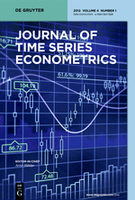
Journal of Time Series Econometrics
Scope & Guideline
Unraveling Temporal Patterns to Inform Economic Theory
Introduction
Aims and Scopes
- Time Series Forecasting:
The journal emphasizes the development and application of forecasting models, including GARCH, SVAR, and neural networks, to predict economic variables such as inflation, asset returns, and commodity prices. - Econometric Methodologies:
It showcases a variety of econometric techniques, including maximum likelihood estimation, impulse-response analysis, and model selection methodologies, contributing to the theoretical advancement of time series econometrics. - Macroeconomic Applications:
There is a consistent focus on applying time series methods to macroeconomic issues, including fiscal policy analysis, commodity market dynamics, and growth hypotheses. - Statistical Learning and Machine Learning:
The journal is increasingly incorporating modern statistical learning techniques, such as recurrent neural networks and ensemble modeling, to enhance predictive accuracy and model robustness. - Robustness and Model Evaluation:
A significant aspect of the journal's scope is dedicated to robustness in econometric modeling, including goodness-of-fit tests and small sample adjustments, ensuring reliable inference and decision-making.
Trending and Emerging
- Complex Volatility Models:
Recent publications highlight a growing interest in advanced volatility modeling techniques, such as GARCH and its variants, particularly in the context of financial markets and cryptocurrencies. - Machine Learning Techniques:
There is a significant rise in the application of machine learning methods, including neural networks for forecasting and portfolio selection, indicating a trend towards integrating computational techniques with traditional econometric approaches. - Dynamic Model Averaging:
The use of dynamic model averaging techniques is becoming more prominent, allowing for more flexible and adaptive forecasting methods in response to changing economic conditions. - Non-Gaussian Error Structures:
An emerging focus on models that accommodate non-Gaussian error distributions reflects a trend towards more accurately capturing the complexities of real-world data. - Robustness in Model Selection:
The journal is increasingly emphasizing the importance of robustness in econometric modeling, with a focus on model evaluation and goodness-of-fit, ensuring that findings are reliable and applicable.
Declining or Waning
- Traditional Econometric Models:
There is a noticeable decrease in the publication of papers focused solely on classical econometric models, such as ARMA and simple regression analyses, as newer methodologies gain prominence. - Deterministic Models:
Research employing deterministic models with less emphasis on stochastic processes seems to be declining, as the field increasingly values stochastic volatility and complex dynamic systems. - Static Analysis:
Papers that primarily address static relationships in time series data are becoming less common, with a clear shift towards dynamic modeling approaches that account for time-varying relationships.
Similar Journals
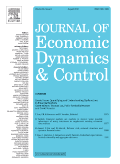
JOURNAL OF ECONOMIC DYNAMICS & CONTROL
Advancing the Frontiers of Economic Dynamics and ControlJOURNAL OF ECONOMIC DYNAMICS & CONTROL, published by Elsevier, is a distinguished scholarly journal that has established itself as a leading outlet in the fields of applied mathematics, control and optimization, and economics and econometrics since its inception in 1979. With its notable Q1 categorization in 2023 across these disciplines, this journal provides a platform for innovative research that propels theory and practice in dynamic systems and control processes. Researchers, professionals, and students can engage with cutting-edge studies that explore complex economic models and their real-world applications. Although the journal does not offer open access, it remains a vital resource for those aiming to stay informed of the latest advancements in economic dynamics and control methodologies. The journal’s commitment to high-quality research and its impressive standing—ranked in the top percentiles within Scopus categories—underscore its importance and influence within the academic community.
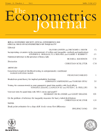
Econometrics Journal
Exploring New Frontiers in Economic MethodologiesEconometrics Journal, published by Oxford University Press, stands as a premier outlet for original research in the fields of Economics and Econometrics, boasting a commendable 2023 Q1 ranking within its category and an impressive 69th percentile rank in Scopus. Since its inception in 2006, the journal has consistently provided a platform for innovative methodologies and applications that contribute to the advancement of econometric theory and practice. With a focus on high-quality, peer-reviewed articles, the journal serves as a vital resource for researchers, professionals, and students alike, facilitating the dissemination of cutting-edge insights that push the boundaries of knowledge in economic analysis. Although it operates under a traditional subscription model, the journal's commitment to excellence and relevance in modern economic discourse positions it as an essential reference for those seeking to navigate the complexities of econometric research.

International Advances in Economic Research
Pioneering Insights in the World of EconometricsInternational Advances in Economic Research, published by SPRINGER, stands as a significant resource within the field of economics and econometrics, consistently contributing to the theoretical and empirical understanding of economic phenomena since its inception in 1995. With an ISSN of 1083-0898 and E-ISSN of 1573-966X, this journal is dedicated to advancing economic research through a rigorous peer-review process and disseminating high-quality scholarly articles. The journal's esteemed classification places it in the third quartile (Q3) within the Economics and Econometrics category for 2023, indicating its respectable standing in academic circles. It serves as an important conduit for the dissemination of innovative economic theories, data analysis, and policy discussions, appealing to researchers, professionals, and students alike. Though not an open-access journal, it provides valuable subscription-based content that enriches the understanding of diverse economic issues and fosters a community of inquiry among academics. With its projected outlook extending to 2024, International Advances in Economic Research continues to be an essential platform for scholars aiming to influence and engage with contemporary economic debates.
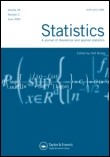
STATISTICS
Exploring the depths of statistical inquiry since 1985.STATISTICS is a distinguished journal published by Taylor & Francis Ltd, dedicated to advancing the field of statistical science since its inception in 1985. With a strong focus on both the theoretical and practical aspects of Statistics and Probability, this journal serves as a vital platform for researchers, professionals, and students seeking to disseminate their findings and contribute to critical discussions in the discipline. Although categorized in the Q3 quartile for both Statistics and Probability and Statistics, Probability and Uncertainty, the journal's commitment to quality research is evidenced by its inclusion in relevant Scopus rankings. It holds respectable positions, ranked #132/168 in Decision Sciences and #219/278 in Mathematics. By providing a venue for high-quality research articles and reviews, STATISTICS aims to foster innovation, reinforce methodological advancements, and address contemporary challenges in statistical applications. The journal does not currently offer open access, but it is widely distributed, ensuring that significant research reaches the communities that need it most. Researchers are encouraged to submit their work to this essential resource that continues to shape the landscape of statistical inquiry.
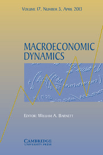
MACROECONOMIC DYNAMICS
Unraveling Macroeconomic Theories and PracticesMACROECONOMIC DYNAMICS, a distinguished academic journal published by Cambridge University Press, serves as a pivotal platform for innovative research in the fields of economics and econometrics. With its ISSN 1365-1005 and E-ISSN 1469-8056, the journal has been at the forefront of scholarly communication since its inception in 1997, offering an extensive range of articles that explore dynamic economic models, policy impacts, and theoretical advancements through the latest empirical analyses. Currently holding a Q2 ranking within the 2023 Economics and Econometrics category, and positioned at rank #409 out of 716 within Scopus, it is an essential resource for researchers, professionals, and students alike, looking to stay updated on critical developments in macroeconomic theory and practice. Although it follows a traditional subscription model rather than Open Access, the journal continually strives to disseminate high-quality, peer-reviewed content that informs and inspires the global economics community. The importance of MACROECONOMIC DYNAMICS lies in its commitment to fostering a deeper understanding of economic phenomena, making it a must-read for anyone engaged in the complexities of the economic landscape.

Thailand Statistician
Fostering Collaboration and Growth in Statistical ResearchThailand Statistician, published by the THAI STATISTICAL ASSOCIATION, is a pivotal journal in the realms of computational mathematics and statistics. With an ISSN of 1685-9057 and an E-ISSN of 2351-0676, this journal aims to disseminate high-quality research and innovative methodologies that advance the fields of statistics and probability. Covering a range of topics from theoretical statistics to applied computational techniques, it provides a platform for researchers, professionals, and students in Thailand and beyond to contribute their findings and insights. The journal has been gaining recognition, boasting a Scopus ranking of Q3 in Computational Mathematics and Q4 in Statistics and Probability as of 2023. With its commitment to open access, the Thailand Statistician stands as an essential resource for those striving to stay abreast of advancements in statistical methodologies and their applications, fostering the growth of statistical science in the region and globally.

Data Science in Finance and Economics
Catalyzing insights for a data-driven future in finance and economics.Data Science in Finance and Economics is a pioneering journal published by the American Institute of Mathematical Sciences (AIMS), devoted to the intersection of data science with the fields of finance and economics. Established as an open-access journal since 2021, it aims to disseminate high-quality research that unravels complex financial phenomena and economic models through innovative data-driven methodologies. With a commitment to advancing knowledge in this rapidly evolving discipline, the journal encourages submissions that encompass theoretical studies, empirical research, and application-based articles from both academia and industry. While the journal is relatively new, its potential to significantly influence the discourse in finance and economics is profound, offering researchers, professionals, and students an invaluable resource to stay abreast of current trends and methodologies in data science. For access to cutting-edge research and insights, visit AIMS and contribute to the ongoing conversation in this essential field.

JOURNAL OF FORECASTING
Empowering decision-making through innovative forecasting.JOURNAL OF FORECASTING, published by Wiley, stands as a vital resource in the fields of forecasting and predictive analytics, dedicated to advancing theoretical and practical knowledge. With a rich history dating back to its inception in 1982, the journal covers an extensive range of disciplines, evidenced by its impressive standing across several Scopus rankings, including Q1 in Modeling and Simulation and Q2 in Economics, Management Science, and Statistics among others. The journal holds an esteemed impact factor, indicative of its rigorous peer-review process and the significance of its contributions, making it essential reading for researchers, practitioners, and students alike. While the journal is not open access, it offers various subscription options to ensure that its valuable content is accessible to a wider audience. As it converges towards its 2024 milestone, the JOURNAL OF FORECASTING continues to forge paths in methodological advancements and empirical applications, reinforcing its reputation as a foremost publication in predictive modeling.

Central European Journal of Economic Modelling and Econometrics
Championing excellence in econometric research and applications.Central European Journal of Economic Modelling and Econometrics (ISSN: 2080-0886, E-ISSN: 2080-119X) is a premier academic publication housed under the auspices of the Polish Academy of Sciences - Lodz Branch. Since its establishment, this journal has served as a crucial platform for scholars and practitioners alike, focusing on the dynamic realms of economic modeling and econometrics. The journal is dedicated to advancing the understanding of economic systems and statistical methodologies, striving to bridge theoretical approaches with practical applications. Although currently categorized in the Q4 quartile across various fields such as Applied Mathematics, Economics, and Statistics, its commitment to rigorous research and scholarly discourse ensures it remains an important resource for academics looking to contribute insights in these sectors. Published in Poland and featuring articles aimed at enhancing the body of knowledge in econometric modeling, this journal embraces an open-access model, allowing for greater dissemination of research findings to a global audience. Researchers, professionals, and students will find valuable contributions that not only highlight emerging trends but also foster innovation in the field of economic sciences.

STUDIES IN NONLINEAR DYNAMICS AND ECONOMETRICS
Illuminating the Intersections of Economics and ComplexitySTUDIES IN NONLINEAR DYNAMICS AND ECONOMETRICS, published by Walter de Gruyter GmbH, is a leading journal that explores the intersections of nonlinear dynamics, econometric modeling, and their applications across various fields. Since its inception in 2002, this journal has been dedicated to disseminating high-quality research that challenges conventional methodologies and promotes innovative analytical techniques in economics and social sciences. With an impressive impact through its rankings, being placed in the Q3 category for Analysis and Econometrics, and achieving a Q2 ranking in Social Sciences (miscellaneous) as of 2023, it serves as a vital resource for scholars and practitioners aiming to deepen their understanding of complex systems and dynamic processes. The journal facilitates open discourse and comprises contributions from both emerging and established researchers, fostering an academic environment that prioritizes rigorous peer-reviewed scholarship. Researchers are encouraged to access its rich content, which provides insights into contemporary methodologies and empirical findings, further enhancing the discourse surrounding nonlinear dynamics and statistics. For more information and to explore the latest research, please visit its page on the publisher's website.